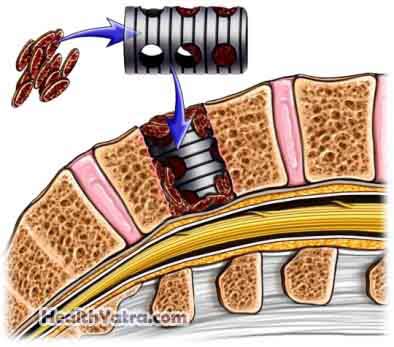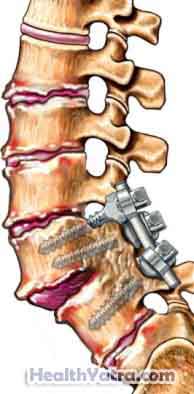Definition
A spinal fusion is a surgery to weld together two vertebrae. Vertebrae are the bones that make up the spine.
Reasons for Procedure
To treat persistent pain and disability caused by:
- Spinal stenosis (narrowing of the canal that the spinal cord runs through)
- Spinal injury
- Spondylolisthesis (vertebra is out of line with the others)
- Scoliosis (abnormal curve in the spine)
- Weak or unstable spine, usually due to infection or tumors
- Herniated disk
Spinal fusion may be done if the treatments below do not relieve pain and disability:
- Rest
- Pain medicines
- Muscle relaxants
- Physical therapy
- Injection of drugs to relieve pain and swelling
- Massage
- Bracing
- Behavior change therapy
Imaging tests must also show a problem that can be fixed with this procedure.
Possible Complications
Complications are rare, but no procedure is completely risk-free. If you are planning to have a spinal fusion, your doctor will review a list of possible complications. These may include:
- Bleeding
- Infection
- Incomplete fusion of the bones
- Blood clots
- Hematoma (build-up of blood in the wound)
- Nerve damage causing pain, numbness, tingling, or paralysis
- Impaired bowel and/or bladder function
- Reaction to anesthesia
Factors that may increase the risk of complications include:
- Smoking
- Poor nutrition
- Obesity
- Advanced age
- Preexisting medical condition
What to Expect
Prior to Procedure
Your doctor may do the following:
- Physical exam, especially of the back and neck
- X-ray—a test that uses radiation to take a picture of structures inside the body, especially bones
- MRI—a test that uses magnetic waves to make pictures of the spinal nerves and disks between vertebrae
- Myelogram—a type of x-ray that uses dye inserted near the spinal cord to show if there is pressure on the cord or the nerves
- Possibly a CT scan—a type of x-ray that uses a computer to make pictures of the bones of the spine
Before your surgery:
- Talk to your doctor about your medicines. You may be asked to stop taking some medicines up to one week before the procedure, like:
- Aspirin or other anti-inflammatory drugs
- Blood thinners, such as clopidogrel (Plavix) or warfarin (Coumadin)
- Arrange for a ride home and for help at home.
- Eat a light meal the night before. Avoid eating or drinking anything after midnight.
Anesthesia
General or spinal anesthesia may be used. With general anesthesia, you will be asleep. Spinal anesthesia will numb an area of your body, but you will be awake.
Description of Procedure
Your doctor will make an incision in your back or neck. The muscles will be spread to access the spine. Your doctor may fuse the bones with either:
- Grafts made from pieces of bone or bony material (the pieces of bone may be taken from the pelvis [hip])
- A small metal cage filled with bone graft material (the cage may be placed between the spinal bones)
Your doctor will implant screws and plates or rods to hold the bones in place while they fuse together. The incision will be closed with stitches or staples.

How Long Will It Take?
4-6 hours (sometimes longer)
How Much Will It Hurt?
Anesthesia will prevent pain during surgery. You will receive medicine after surgery to help manage pain.
Average Hospital Stay
3-4 days (sometimes less, sometimes more, depending on age, overall health, and extent of surgery)
Post-procedure Care
At the Hospital
You may receive the following care at the hospital:
- Pain medicine
- Back brace or cast
- Lessons on how to properly move, sit, stand, and walk
- Lessons on how to turn in bed without twisting the spine
- Physical therapy
- Special socks or boots to help prevent blood clots
- You will be shown how to move and exercise your legs while in bed
- You will be encouraged to get up and walk around several times a day
At Home
When you return home, do the following to help ensure a smooth recovery:
- Be sure to follow your doctor’s instructions.
- Keep the incision area clean and dry.
- Ask your doctor about when it is safe to shower, bathe, or soak in water.
- Exercise your legs while in bed. This improves circulation and decreases the risk of blood clots.
- Do not lift anything heavy.
- The bones and grafts fuse together over several months. Your activity will be restricted during this time.
- Only take medicine recommended by your doctor. Ask your doctor before taking any over-the-counter medicine.
- Have the stitches or staples removed in two weeks.
- Your doctor may tell you to permanently avoid heavy lifting and strenuous activities that involve lifting and twisting.
Rehabilitation
Rehabilitation may be done in a hospital or at an outpatient clinic. The program will likely include:
- Exercises to strengthen your back
- Low-impact aerobic exercises, such as walking or swimming
Time off from work ranges from 4-6 weeks to 4-6 months. It depends on your age, overall health, and the physical demands of your job.
Complete healing of the bones may take up to one year after surgery. You will likely notice less flexibility of your spine where the bones are fused. Following your rehabilitation program will speed your recovery and reduce discomfort.

Call Your Doctor
After you leave the hospital, contact your doctor if any of the following occurs:
- Signs of infection, including fever and chills
- Redness, swelling, increasing pain, excessive bleeding, or discharge from the incision site
- Nausea and/or vomiting that you cannot control with the medicines you were given after surgery, or which persist for more than two days after discharge from the hospital
- Pain that you cannot control with the medicines you have been given
- Cough, shortness of breath, or chest pain
- Joint pain, fatigue, stiffness, rash, or other new symptoms
- Numbness, tingling, pain, or weakness, especially in the arms, hands, legs, or feet
- Pain, swelling in your feet, legs, or calves
- Loss of bladder or bowel function
- Pain, burning, urgency, frequency of urination, or persistent blood in the urine
In case of an emergency, call for medical help right away.
